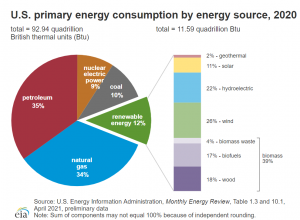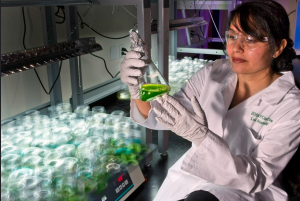3 Bio and Hydrogen Fuel
Savana Wolf
3.1 Introduction
Keywords
- Biomass – plant material
- Biofuel – biomass which has been converted into liquid fuels
- Hydrocarbon – a carbon-hydrogen structure found in organic molecules
- Ethanol – a type of alcohol made from biomass and is usually mixed with gasoline to reduce greenhouse gas emission in vehicles
- Biodiesel – diesel made from oils and fats (both plant and animal based) combined with alcohol
- Steam-methane reforming – a method of hydrogen production which involves reacting methane with high pressure and temperature steam using a catalyst to produce hydrogen with by-products of carbon monoxide and dioxide
- Electrolysis – a method of hydrogen production which uses an electric current to split hydrogen from oxygen in water
Learning Objectives
By the end of this chapter, students should be able to:
- Identify the different types and process of production of biofuel and hydrogen fuel
- Give a brief history on the development of biofuel and hydrogen fuel
- Describe the current benefits and drawbacks to biofuel and hydrogen fuel
- Give a prediction for the future of biofuel and hydrogen fuel

“U.S. primary energy consumption by energy source, 2020” by U.S. Energy Information Administration is in the Public Domain
As humanity strides into the future, new technologies continue to be developed with the aim of solving the newfound problems faced in the journey forward. One of the biggest problems, of course, is that of energy and the current state of the environment, and finding a way to consume energy while mitigating the subsequent environmental consequences. Already the movement away from non-renewable towards renewable energy sources has begun, and there are many currently developed technologies and forms of energy which aim at being the solution to this problem (as discussed in the previous chapter). However, the limitations of these forms of energy mean they must undergo much more development before they are able to be a viable source of energy.
Instead of limiting themselves to a limited number of renewable energy sources, humanity has worked to expand their technologies and have begun developing new forms of renewable energy which are even more efficient and practical than their predecessors: renewable fuels. With much of the human energy consumption and dependencies stemming from non-renewable fuel sources, the development of renewable fuels is a practical and logical stepping stone in the path towards completely green energy consumption. These renewable fuels in development will ultimately provide long term solutions to the current energy crisis and bring majority positive benefits to the environment and society.
In this chapter, the renewable fuels of bio- and hydrogen fuel will be explored, including what they are, their history as forms of renewable energy, their benefits and drawbacks, and their outlook as future forms of energy.
3.2 Biofuels

“Growing a greener future with algal biofuels” by Los Alamos National Laboratory is licensed under CC BY-NC-ND 2.0
3.2.1 What are Biofuels?
Key Takeaway
Biofuels are biomass (plant material) which have been converted into liquid fuels. The most common types of biofuel are ethanol and biodiesel, but renewable hydrocarbons are also growing as another viable biofuel.
- Ethanol is a type of alcohol made from biomass and is usually mixed with gasoline to reduce greenhouse gas emission in vehicles. It is made by fermenting biomass with microorganisms (like yeast).
- Biodiesel is made from oils and fats (both plant and animal based) combined with alcohol. Biodiesel is directly replaceable with traditional diesel in most vehicles in use today.
- Renewable hydrocarbons consist of hydrocarbons, like those found in traditional gasoline, produced from biomass by either biological or thermochemical processes.
To produce all types of biofuels, the cell wall of the biomass is broken down so sugar polymers like cellulose can be freed. The sugar polymer mixture is then processed either biologically (by microorganisms like yeast) or chemically (using catalysts).
Biofuel generally comes from one of two distinct sources: food or non-food resources. Food resource fuel refers to fuel that has been produced from biomass that is edible by humans (like corn) whereas non-food resource fuel is made from biomass not edible by humans (like corn husk).
3.2.2 History of Biofuels
Key Takeaway
Biofuel was used sparsely until the early 1900’s, but true research and development on it began in the 1970’s.
The first biofuel ever used was ethanol, but it was only used experimentally to power select engines in the 1820’s and again in the 1870’s; its use as a biofuel was stunted in the United States due to alcohol taxes which covered the purchase of ethanol. It was reintroduced as a fuel again in the early 1900’s with its use in the Ford Model T and gained more popularity in the 1920’s and 30’s as an additive to regular gasoline during the gasoline shortages of World War 1.
However, the biofuel industry (as it exists today) truly emerged in the 1970’s as a result of the oil crisis of the decade. Research and development of sources like ethanol and algae based fuel increased dramatically as a result of shifting perspectives on the environment and concern over the dependence on nonrenewable fuel sources. Since then, there have been dramatic developments in the development and production of biofuels, bringing it closer to large-scale production able to rival that of non-renewable fuel sources.
3.2.3 Impact of Biofuels
Key Takeaway
General biofuels have many advantages, both to the environment and to society. For example, newer forms of non-food resource fuels have little to no interference with human food production, meaning (unlike in earlier years) food sources which could go to malnourished communities are not being used to produce biofuels. Further, algae specifically is a source of biofuel that absorbs excess carbon dioxide from the atmosphere (helping to alleviate some of the environmental concern with excess greenhouse gases) and can treat wastewater in its production (wastewater which otherwise would have required more energy to treat). On the other hand, biodiesel is biodegradable and non-toxic (unlike current diesel) and is able to be used in current diesel running engines, meaning no altering of residential or commercial diesel engines is needed in order to implement the use of biodiesel. Overall, the use of biofuels (as opposed to traditional fossil fuels) significantly reduces the output of toxic and greenhouse gasses, creating a healthier environment in which to live.
3.2.4 The Future of Biofuels
Key Takeaway
There are still challenges associated with the production of biofuels which prevent them from being implemented on a larger scale- the main challenge being production cost. The production of biofuels is still a monetarily and energy expensive process, and is also not very efficient in the biomass input to biofuel output ratio. Thus, research is currently being done in reducing the monetary cost of production, reducing the amount of energy needed to produce a unit of fuel, and developing processes with higher percent yields of biofuel per biomass input. In addition, alternate non-food sources of biomass are continuing to be researched, with the goal of eventually having no impact on the food production process (thus, no use of food resources for fuel or use of land or resources for biomass which could be used for food production). Research into algae based fuel sources specifically have included further investigation of wastewater as the main growing environment in order to reduce the amount of potable water used in production as well as treat the otherwise unusable water.
If these elements of biofuel production could eventually be improved upon, biofuel could easily become a large-scale renewable fuel source with the ability to replace virtually all use of non-renewable fuels and create a cleaner environment for the future generations.
3.3 Hydrogen Fuel

“Toyota MIRAI and Hydrogen Fueling Station : トヨタ MIRAIと水素ステーション” by Toshihiro Gamo is licensed under CC BY-NC-ND 2.0
3.3.1 What is Hydrogen Fuel?
Key Takeaway
Hydrogen is an element which carries energy but must be produced from another source (like water or biomass) in order to be used as a fuel. It can be produced using the processes of steam-methane reforming or electrolysis.
- Steam-methane reforming is most widely used in commercial production and involves reacting methane with high pressure and temperature steam using a catalyst to produce hydrogen with by-products of carbon monoxide and dioxide. The methane used in this process can come from landfills/biogas or biofuels.
- Electrolysis, on the other hand, uses an electric current to split hydrogen from oxygen in water; the electricity used can come from renewable sources like solar or wind power.
Hydrogen can also be used in fuel cells, which combine hydrogen and oxygen to produce electricity. The only by-product of hydrogen fuel and hydrogen based fuel cells is water and these cells contain triple the amount of energy of gasoline and natural gas. However, hydrogen based energy/fuel is currently one of, if not the, most expensive forms of renewable energy fuel
3.3.2 History of Hydrogen Fuel
Key Takeaway
The history of hydrogen fuel usage is closely tied to the space industry.
The uses of hydrogen as a fuel and energy source began in the 1950’s, when NASA began using liquid hydrogen as rocket fuel. Around the same time, NASA also became one of the first to use hydrogen fuel cells as a source of energy for electrical systems on spacecraft.
Throughout history, hydrogen fuel and power has had strong connections to the space industry: hydrogen fuel has been used to fuel the Centaur and Apollo program rockets, as well as various other space shuttlecraft. More recent developments in the use of hydrogen as fuel come in using varying types of fuel cells with hydrogen as a reactant within the cell.
3.3.3 Impact of Hydrogen Fuel
Key Takeaway
Hydrogen fuel has social and environmental effects particularly beneficial for cities.
Hydrogen fuel, though not currently used on a wide commercial and residential scale, has had some proven positive social and environmental benefits. For one, hydrogen fueled vehicles and other applications can be less noisy, reducing noise pollution for various populations. This benefits large cities, where noise pollution due in part to vehicles has become common. Additionally, fuel cells using hydrogen are two to three times more efficient than gasoline powered internal combustion engines, while also producing zero emissions. This makes for a much more efficient and environmentally friendly vehicle, and also (as stated above) would be beneficial for cities where pollution and smog are problems.
3.3.4 The Future of Hydrogen Fuel
Key Takeaway
In order for hydrogen fuel and power to become a feasible source of renewable energy in the future, more research into the successful large-scale implementation of renewable energy sources (like solar and wind) to power the production of hydrogen fuel is needed for the process to become cost effective enough to produce on a large scale. Successful implementation would include ways to ensure reliable energy flow from these sources (as they are reliant upon natural resources/processes outside of human control) as well as lowered installation and energy storage costs. Renewable sources of energy also need to be able to effectively compete with existing non-renewable sources of energy in order to be feasible enough to be used to produce hydrogen fuel (especially on a large scale); thus, these improvements in reliability and powered installation costs are imperative. Currently, research into using algae and other sources of biomass/biofuel as sources of hydrogen fuel is being done in order to lower the cost of production.
3.4 Chapter Summary
Biofuel and hydrogen fuel are two forms of renewable energy which are currently under development and look to be promising alternatives to the non-renewable fuel sources in use today. For both of these forms of fuel, there exist multiple forms and manners of production which provide many options for their production and consumption. Further, these fuels have a recent history of development and current, ongoing research into the betterment of their production. Due to their newness as forms of energy, there are still many challenges in their production (mainly that of expense and efficiency) but once these challenges are overcome, these fuels reap many positive social and environmental benefits- the most prominent of which being greatly reduced harmful emissions. Overall, these renewable fuels in development will provide long term solutions to the current energy crisis and bring majority positive benefits to the environment and society.
Review Questions
- Which of the following are types of biofuels?
A. Biodiesel
B. Renewable hydrocarbons
C. Ethanol
D. All of the above
- What industry does the development of hydrogen fuel have close ties with?
A. Clothing industry
B. Automobile industry
C. Space industry
D. Computer industry
- When did the biofuel industry as it is seen today begin to develop?
A. 1920’s
B. 1930’s
C. 1870’s
D. 1970’s
Answers:
-
- D
- C
- D
Food for Thought
- There is, of course, a very limited amount of funding which can be given for research into new technology. Given this, which renewable fuel type would be the best to invest in? Why?
- Think about the rise and fall in popularity of different forms of energies throughout human history. What factors cause this change in popularity? Are there any patterns to these causes, and what do you think this says about human society as a whole?
References
Bioenergy Technologies Office. (n.d.). Biofuel basics. Energy.gov. Retrieved November 9, 2021, from https://www.energy.gov/eere/bioenergy/biofuel-basics.
Gustafson, C. (n.d.). History of Ethanol Production and Policy. Energy- North Dakota State University. Retrieved November 18, 2021, from https://www.ag.ndsu.edu/energy/biofuels/energy-briefs/history-of-ethanol-production-and-policy.
Hydrogen explained. (2021, January 7). US Energy Information Administration. Retrieved November 18, 2021, from https://www.eia.gov/energyexplained/hydrogen/.
Hydrogen explained: Production of hydrogen. (2021, January 7). US Energy Information Administration. Retrieved November 18, 2021, from https://www.eia.gov/energyexplained/hydrogen/production-of-hydrogen.php.
Hydrogen explained: Use of hydrogen. (2021, January 7). US Energy Information Administration. Retrieved November 18, 2021, from https://www.eia.gov/energyexplained/hydrogen/use-of-hydrogen.php.
Kafaei, M., Sedighizadeh, D., Sedighizadeh, M., & Fini, A. S. (2022). An IGDT/Scenario based stochastic model for an energy hub considering hydrogen energy and electric vehicles: A case study of Qeshm Island, Iran. International Journal of Electrical Power & Energy Systems, 135, N.PAG. https://doi-org.libproxy.clemson.edu/10.1016/j.ijepes.2021.107477.
Kandasamy, S., Zhang, B., He, Z., Bhuvanendran, N., EL-Seesy, A. I., Wang, Q., Narayanan, M., Thangavel, P., & Dar, M. A. (2022). Microalgae as a multipotential role in commercial applications: Current scenario and future perspectives. Fuel, 308, N.PAG. https://doi-org.libproxy.clemson.edu/10.1016/j.fuel.2021.122053.
Renewable energy explained. (2021, May 20). U.S. Energy Information Administration. Retrieved November 9, 2021, from https://www.eia.gov/energyexplained/renewable-sources/.
Siddiki, S. Y. A., Mofijur, M., Kumar, P. S., Ahmed, S. F., Inayat, A., Kusumo, F., Badruddin, I. A., Khan, T. M. Y., Nghiem, L. D., Ong, H. C., & Mahlia, T. M. I. (2022). Microalgae biomass as a sustainable source for biofuel, biochemical and biobased value-added products: An integrated biorefinery concept. Fuel, 307, N.PAG. https://doi-org.libproxy.clemson.edu/10.1016/j.fuel.2021.121782.
Space Applications of Hydrogen and Fuel Cells. (2021, May 27). Explore Space Tech- NASA. Retrieved November 18, 2021, from https://www.nasa.gov/content/space-applications-of-hydrogen-and-fuel-cells.
Xiang, H., Ch, P., Nawaz, M. A., Chupradit, S., Fatima, A., & Sadiq, M. (2021). Integration and economic viability of fueling the future with green hydrogen: An integration of its determinants from renewable economics. International Journal of Hydrogen Energy, 46(77), 38145–38162. https://doi-org.libproxy.clemson.edu/10.1016/j.ijhydene.2021.09.067
Plant material.
Plant material.
A carbon-hydrogen structure found in organic molecules.
A method of hydrogen production which involves reacting methane with high pressure and temperature steam using a catalyst to produce hydrogen with by-products of carbon monoxide and dioxide.
A method of hydrogen production which uses an electric current to split hydrogen from oxygen in water.

